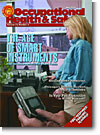
May 2006
- The Age of Smart Instruments
- Solving Mold Problems
- Is Your Fall Protection a Silent Hazard?
- Responding to Laboratory Emergencies
Click here to subscribe.
Cover Story
By Kay Mangieri
Imagine a world where everything in your home and workplace is automated to the point that you are never caught off guard with unforeseen, costly repairs. Imagine never having to call the emergency number for the electrician or pay exorbitant fees for a weekend visit from the refrigerator repairman.
Features
By Elizabeth Hacker
N any work environment, employers need to consider environmental controls before ever putting an employee in personal protective equipment, such as a respirator, to protect them from dangerous contaminants. A fume extraction system should be one of the first steps to minimize employees' exposure of chemicals and particulates.
By Casey Hayes
LABORATORIES can be dangerous places. Because research and teaching labs often work with such a wide variety of potentially volatile and hazardous substances, they are bound by some very strict operational protocols and safety procedures.
By Ron Cox
EACH year, more than 100,000 injuries and deaths are attributable to work-related falls. According to the National Safety Council, falls are one of the leading causes of deaths in the workplace. In addition to permanent injuries and lost lives caused by falls, businesses lose billions of dollars each year from significant increases in insurance premiums, worker's compensation claims, product liability costs, and other related expenses.
By Myles Druckman, M.D.
WHEN the first human cases of avian flu arose in Asia, employees in the affected areas became anxious and, in some cases, terrified. Anxiety and rumors spread, as did the virus, and people were dying--young, healthy people. Asian operations of multinational companies raised the alarm to their corporate offices in the United States.
By Marc Barrera
PICTURE the manufacturing industry as the process of constructing walls. Early manufacturing began by piling one large, irregular-shaped stone atop another, resulting in a wall that was sturdy because of its weight and size but demanding maximum space and materials and reaching only a fraction of its strength potential. As the industry progressed, these stones were shaped into blocks that fit one along another, increasing stability while reducing space and materials.
By D. Jeff Burton, PE, CIH
What is "duct cleaning"?
Ductwork sometimes can become both the source and the pathway for dirt, dust, and biological contaminants to spread through the building. In this case, duct cleaning usually means the removal of dirt, slime, mold, debris, and other materials found in ductwork and other HVAC components (e.g., cooling coil, drain pan).
By Joseph Weigel
SHORTcircuits and faults in electric power systems are nothing new--and are typically damaging and even deadly. One type of fault that has received particular attention in recent years is the arc fault, or fault current that travels through the air, which differs from the bolted fault current that flows through conductors, busbars, or other equipment optimally designed to withstand its effects.
By Jerry V. DeRosa, CHMM
IN the aftermath of Hurricane Katrina, mold has been receiving substantial press, and for good reason. Many health conditions have been attributed to mold exposure; as a result, there have been more than 10,000 mold-related lawsuits in the United States and the coining of the term "toxic mold."
By Judith Green-McKenzie, M.D., MPH, FACOEM, FACP, David J. D'Souza, M.D., MPH, FACOEM
RESPIRATORS are essential personal protective equipment for protection against some airborne biological hazards in health care settings, tuberculosis (TB), the virus causing severe acute respiratory syndrome (SARS), avian influenza, and smallpox virus among them.
By Stephen V. Magyar, Jr., MBA, CSP
THE most critical element in ensuring that work inside confined spaces is completed safely is the ability to anticipate safety problems before they become life threatening. Hazard evaluation can be as simple as evaluating changes in work attitude or as complex as evaluating environmental conditions.
Departments
By Jerry Laws
AT least 5 million people worldwide die from injuries each year. Two professors in Seattle have declared a global campaign to prevent 20 percent of those deaths, saying it is "within our grasp" to save about 1 million lives annually.